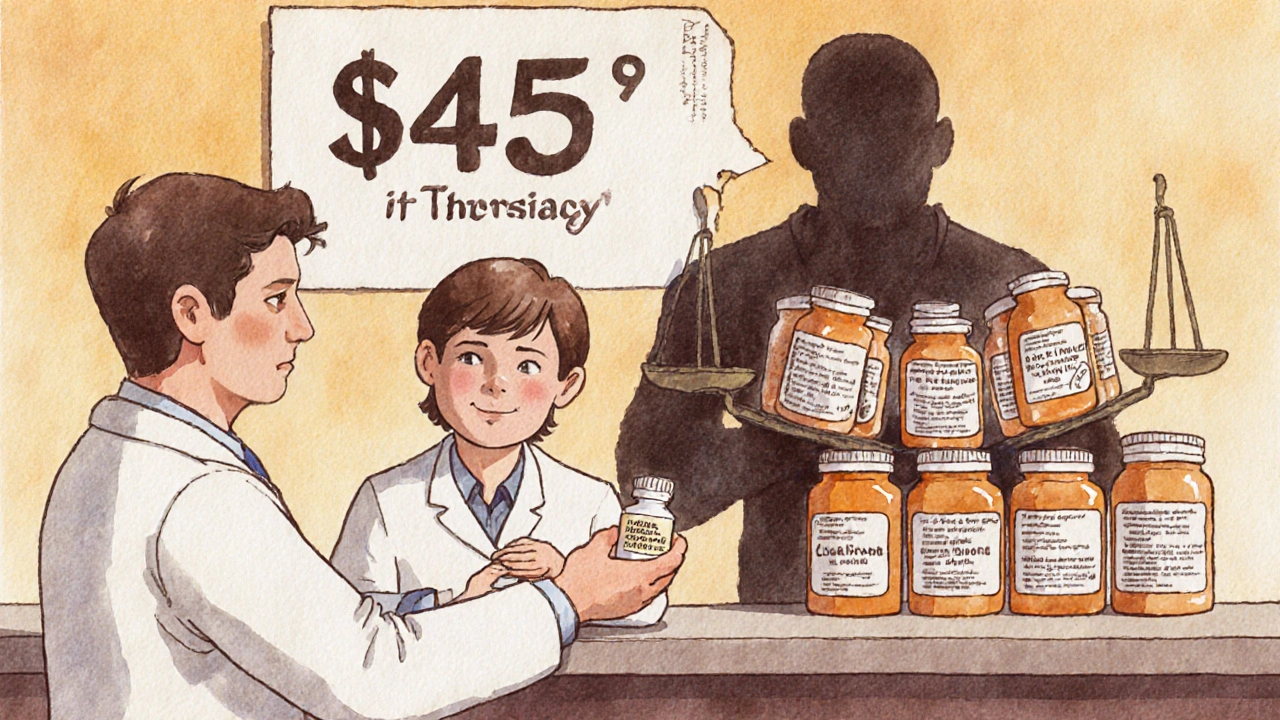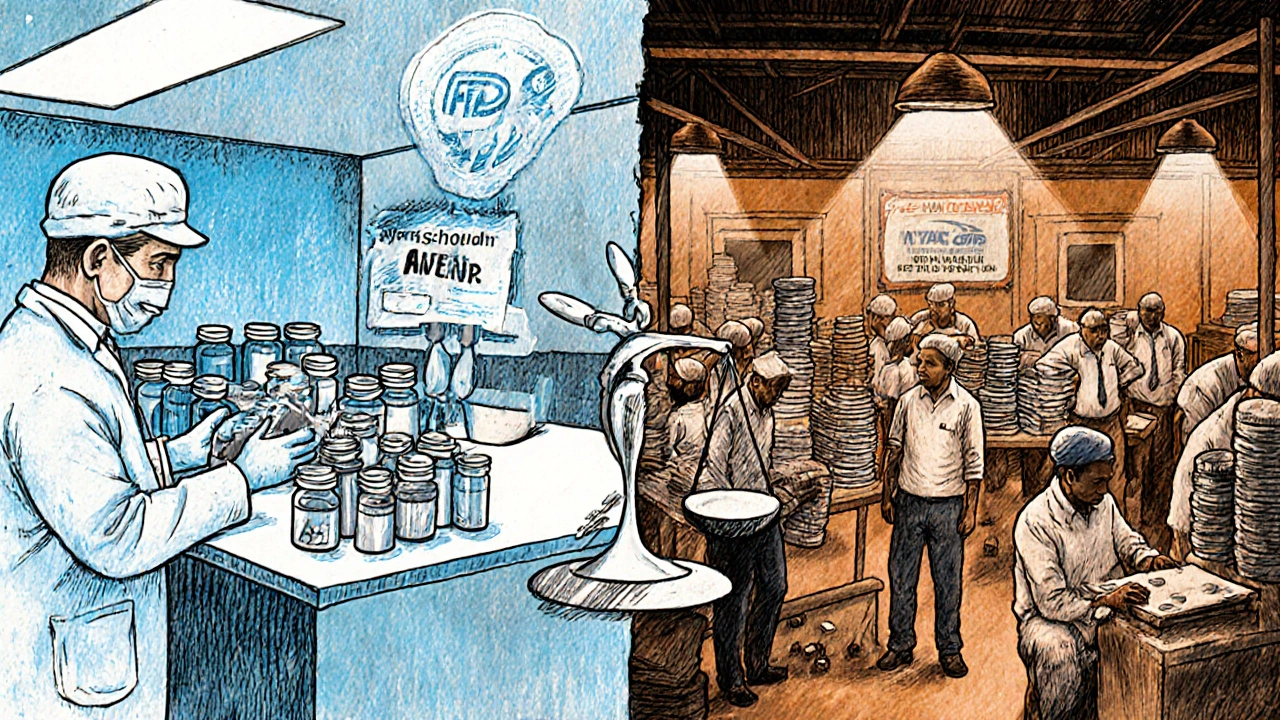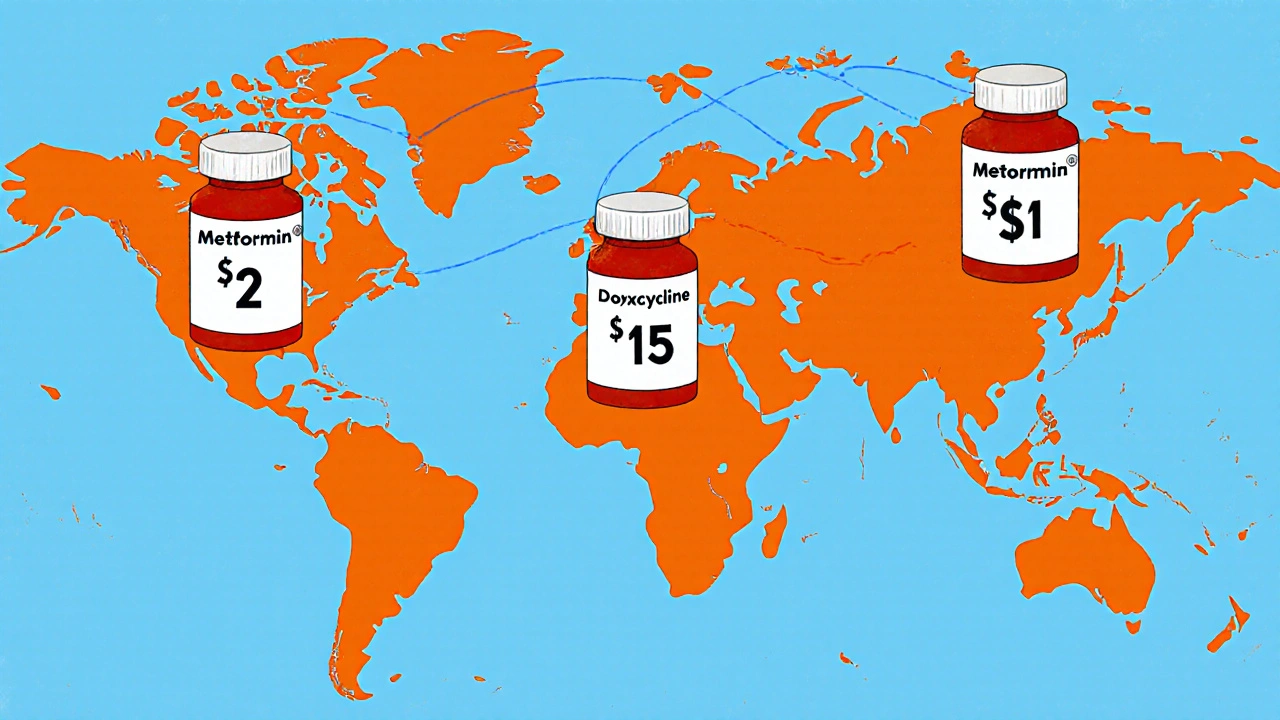Why does a common blood pressure pill cost $2 in India, $12 in Germany, and $45 in the United States - even when it’s made by the same factory? The answer isn’t about quality, brand, or effectiveness. It’s about generic availability - and how different countries treat the same medicine after its patent expires.
What Exactly Is a Generic Drug?
A generic drug contains the same active ingredient, dose, and intended use as the original brand-name version. It works the same way in your body. The only differences are usually in color, shape, or inactive ingredients like fillers - things that don’t affect how the medicine works. Once a brand-name drug’s patent runs out, other companies can legally make copies. These are generics. But here’s the catch: just because a generic exists doesn’t mean it’s easy to get. In some countries, doctors and patients rarely use them. In others, they’re the default choice. The difference comes down to policy, culture, and money.Where Are Generics Used the Most?
The United Kingdom leads the world in generic use. About 83% of all prescriptions filled there are for generic drugs. Germany isn’t far behind at 80%. The Netherlands, Canada, and Australia also have high rates - often above 70%. These countries don’t just allow generics; they actively encourage them. Pharmacists can swap a brand for a generic unless the doctor says no. Insurance systems pay less for generics, so there’s a financial push to use them. On the other end of the spectrum are countries like Switzerland, Italy, and Greece. In Switzerland, only about 17% of prescriptions are for generics. Why? For one, doctors and patients trust the original brand more. There’s also less financial pressure to switch. Reimbursement rates for brand-name drugs are often higher, so there’s no real incentive to choose the cheaper option. The United States is a paradox. It has one of the highest generic usage rates - over 90% of prescriptions are for generics. But it also has the highest drug prices in the world. How? Because even though most prescriptions are for generics, the prices of those generics are often inflated. Some older generics, like metformin or doxycycline, have seen price spikes of 500% or more in a single year. That’s not because of supply shortages. It’s because a few companies control the market and raise prices when competition drops.Why Are Prices So Different?
Price differences aren’t random. They’re built into how each country’s health system works. In the UK, the National Health Service negotiates prices directly with manufacturers. If a company won’t lower its price, the drug gets taken off the list of reimbursed medicines. That forces competition. In Germany, prices are set by law based on what other countries pay. If a generic is cheaper in Poland, it can’t be sold for more in Germany. In the U.S., there’s no central price negotiation. Pharmacies and insurers pay what manufacturers charge. And manufacturers know that patients often can’t switch easily - especially if they’re on long-term medication. That gives them power to raise prices without losing customers. India produces about 20% of the world’s generic drugs - and 40% of the ones used in the U.S. Yet, the same pill costs 63% less in India than in Belgium. Why? Because Indian manufacturers operate on thin margins. They make billions of pills, sell them cheaply, and rely on volume. In Europe and the U.S., those same pills get repackaged, shipped, taxed, and marked up multiple times before they reach the pharmacy shelf.
Who Makes These Drugs - And Is It Safe?
Most generic drugs are made in just a few countries: India, China, and a handful of places in Europe and the U.S. India alone has over 750 manufacturing sites approved by the U.S. Food and Drug Administration (FDA). But quality isn’t guaranteed just because a factory is FDA-approved. A 2023 study from Ohio State University found that generic drugs made in India were linked to 54% more severe side effects - including hospitalizations - compared to identical pills made in the U.S. The issue? Cost-cutting. When a company makes 100 million pills for $0.02 each, corners get cut. Ingredients might be less pure. Storage conditions might be poor. The FDA inspects foreign plants, but inspections are often announced in advance - meaning companies have time to clean up before inspectors arrive. In the U.S., inspections are usually unannounced. That’s one reason why U.S.-made generics tend to be more consistent. But most U.S. generics aren’t made in the U.S. They’re imported. So the safety gap is real.Why Do Some Countries Resist Generics?
It’s not always about money. In Switzerland, many patients believe brand-name drugs are better - even when there’s no scientific proof. Doctors, too, are trained to prescribe the original. There’s a cultural trust in big pharmaceutical companies. In Italy and Greece, the healthcare system is fragmented. Pharmacists can’t substitute generics without the doctor’s approval. That means every prescription needs a new signature. It’s slow. It’s inefficient. And it keeps brand-name drugs in use longer. Even in countries with high generic use, problems remain. In Canada, a patient might get a generic made in India. But if they travel to the U.S., they get a different version - maybe from a different factory. The active ingredient is the same, but the fillers aren’t. Some people report new side effects - nausea, dizziness - because their body reacted to a different binder or coating.
What’s Changing?
Governments are starting to notice the gaps. The European Union wants 80% generic use across all member states by 2030. The U.S. Inflation Reduction Act of 2022 gives the FDA more money and staff to review generic applications faster - and to inspect foreign factories without warning. The World Health Organization launched a new tool in 2024 to help countries measure how well their generic drug systems work. Are generics available? Are they affordable? Are they safe? Countries that score poorly are being pushed to fix their rules. One big change coming? Biosimilars - generics for complex biologic drugs like those used for cancer or autoimmune diseases. These are harder to copy, so they’re more expensive. But when they launch, they can cut costs by 50%. That’s the next frontier.What Does This Mean for You?
If you’re on a long-term medication, know this: the pill you take today might not be the same as the one your neighbor takes - even if it has the same name. - If you’re in the U.S., ask your pharmacist: “Is this made in India or the U.S.?” If you notice new side effects after switching generics, tell your doctor. - If you’re in Europe and your prescription is expensive, ask if a cheaper generic is available. Many countries have databases showing prices across borders. - If you travel often, carry a list of your medications with the active ingredient (e.g., “losartan 50 mg”) - not just the brand name. That way, if you need to refill abroad, you know what to ask for. - Don’t assume cheaper = unsafe. Many Indian-made generics are perfectly safe. But if you’ve had bad reactions before, stick with the same manufacturer. The global generic drug market is worth $450 billion. But the system is broken in places. It’s not about whether generics work - they do. It’s about whether we treat them like essential medicine - or just another commodity to be priced for profit.Are generic drugs as effective as brand-name drugs?
Yes. By law, generic drugs must contain the same active ingredient, strength, dosage form, and route of administration as the brand-name version. They must also meet the same strict standards for quality, purity, and potency. The only differences are in inactive ingredients - like fillers or coatings - which don’t affect how the drug works in your body.
Why are generic drugs cheaper if they’re the same?
Generic manufacturers don’t have to repeat expensive clinical trials. They only need to prove their version works the same as the original. That saves millions in development costs. They also compete with each other - driving prices down. In countries with strong price controls, this competition is enforced by law.
Can I trust generics made in India or China?
Many are safe and effective. Over 750 Indian facilities are FDA-approved. But quality varies. Some manufacturers cut corners to reduce costs, especially for older, low-margin drugs. If you’ve had side effects after switching to a new generic, it could be due to different inactive ingredients - not the active drug. Keep track of the manufacturer name and report any changes to your doctor.
Why do U.S. generic prices spike even when there’s competition?
Sometimes, competition disappears. If all but one or two companies stop making a drug - due to low profits or manufacturing issues - the remaining makers can raise prices. This happened with dozens of old generics like doxycycline and cyclosporine. The FDA and Congress are now trying to prevent this by speeding up approvals and penalizing price gouging.
Can I buy cheaper generics from other countries?
Some people buy from Canadian or Indian online pharmacies and save 60-80%. But buying from foreign sites is legally risky in the U.S. and some EU countries. There’s also no guarantee the product is authentic or properly stored. If you do this, use verified pharmacy websites like PharmacyChecker, and always check the manufacturer and expiration date.


Gerald Cheruiyot
It’s wild how the same pill can cost 20x more just because of where you live. The system isn’t broken-it’s designed this way. Profit over people. End of story.
daniel lopez
90% of prescriptions are generics? Yeah, and that’s why your kid’s asthma inhaler costs $300. Big Pharma and the FDA are in bed together. They let unsafe Indian factories ship poison because they’re too lazy to inspect them properly. Wake up people.
Katie Magnus
Okay but like… why do we even pretend generics are the same? I switched to a cheaper metformin and felt like I’d been hit by a bus. My body knew. It just knew. Like, my soul felt betrayed. 🤮
King Over
India makes most of our generics and still charges pennies. Meanwhile we pay $45 for the same thing. The math doesn’t lie. It’s just not profitable to fix it.
Johannah Lavin
My grandma takes doxycycline and she swears the blue ones make her dizzy but the white ones are fine. She doesn’t know why. She just knows. I think we need to stop treating medicine like cereal and start treating it like life support. 💙
Ravinder Singh
As someone from India where we make half the world’s generics, I can tell you-we’re not cutting corners because we’re lazy. We’re cutting corners because the world demands it. A pill that costs $0.02 here? In the US, it’s $1.20 after shipping, taxes, middlemen, and profit margins. We’re not the villains. The system is.
Our factories are FDA-approved. Yes, some are shady-but so are some US ones. The real issue? No one checks unannounced in India. That’s the fix. Not blame.
And yes, I’ve had side effects from US generics too. Different fillers. Same active ingredient. Your body notices. It’s not magic. It’s chemistry.
Stop vilifying the makers. Start vilifying the middlemen. And if you’re in the US? Ask your pharmacist who made your pill. That’s power.
We’re not trying to sell you poison. We’re trying to keep you alive on a budget. You’re welcome.
Russ Bergeman
Wait, so you’re saying that the FDA doesn’t inspect every single batch? And that some manufacturers use inferior fillers? And that this is why people get sick? And that this is legal? And that we’re all just… supposed to accept this? I mean… wow. Just… wow.
Dana Oralkhan
I’ve been on the same blood pressure med for 12 years. Last year my pharmacy switched generics without telling me. I got dizzy. My BP spiked. I didn’t know why until I checked the label. The manufacturer changed. I called my doctor. We switched back. This shouldn’t be a mystery. People need to know what’s in their pills. It’s not just chemistry-it’s trust.
Jeremy Samuel
Generics? Nah bro. I only take the blue ones. The white ones give me bad vibes. Plus I heard they use rat glue as filler in India. Just saying. 🤷♂️
Destiny Annamaria
My cousin in Germany pays $3 for the same pill I pay $45 for. I asked him how. He said: "Ask your government to negotiate." I said: "...I can do that?" He said: "Yes. You have a vote." I cried. Not because I was sad. Because I realized I’d been asleep.
Ron and Gill Day
So let me get this straight. You’re blaming the U.S. for high prices, but you’re praising India for making cheap pills? You’re literally saying it’s okay to risk your life for a dollar. That’s not progressive. That’s surrender.
Summer Joy
OMG I just realized… my sister’s generic Zoloft is made in China and mine is made in the U.S. She’s been crying every night for months. I thought it was depression. What if it’s the pill? 😭